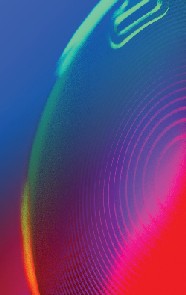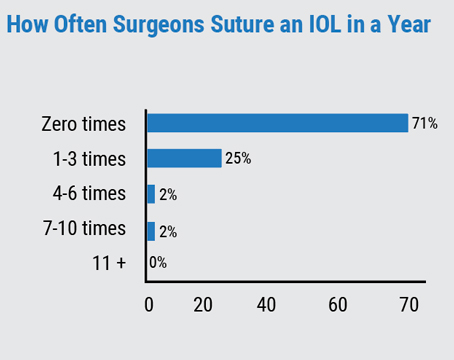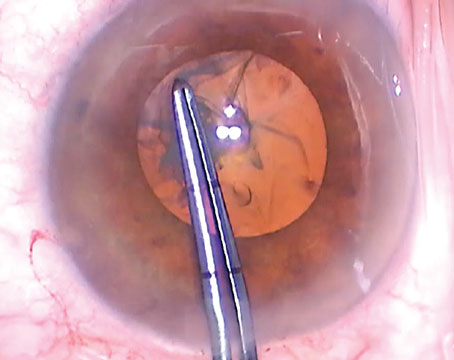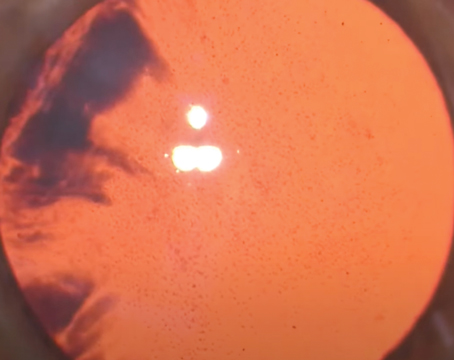SEVERAL ASPHERIC INTRAOCULAR LENSES—lenses in which the front surface is not curved as part of a sphere but is relatively flatter in the periphery—have hit the market and reportedly provide superior contrast sensitivity over the more traditional spherical IOLs. Currently, investigators at companies such as Alcon and Bausch & Lomb are studying the effects the aspheric IOLs on contrast sensitivity.
Available aspheric IOLs include the SofPort AO from Bausch & Lomb, the Tecnis Z9000 from AMO Inc., and the AcrySof SN60WF, from Alcon. Leading surgeons and researchers explain the science, benefits and limitations of these newer aspheric lenses.
Benefit or Not?
Although aspheric IOLs appear to improve contrast sensitivity, it is the retina that may limit the patient's final visual acuity.
"It is often the product of the retina and optics that determines visual function after cataract surgery," explains Joseph Markoff, PhD, MD, director of visual physiology at Wills Eye Hospital in Philadelphia. "When you are dealing with patients in their sixth through ninth decades of life the macula is not what it was at age 20. If you put the Hubble Telescope in an eye with impaired macula functioning, the patient may be disappointed after cataract surgery," he says.
He points out that ganglion cells determine contrast sensitivity. "Everyone loses ganglion cells with age," he says. "It is the ganglion cells that determine contrast sensitivity, and there are many peer-reviewed papers that support this."
Dr. Markoff adds that the science and optics of aspheric IOLs represent an advancement in the state of the art. "I commend the companies for trying to go the extra mile with this technology, but remember, the final common path is often limited by macula function, which is less robust in older age and often cannot be improved with optical correction," he explains.
Today younger and younger patients are receiving cataract surgery. "If a patient has a macular problem, [he] will not see the benefit of this as much as a patient who has a very good macula," says Griff E. Altmann, engineering fellow with Bausch & Lomb. "However, because we are doing cataract surgery on younger and younger eyes and diet is getting better, more and more people have good maculas, and problems with a macula are not much of an issue," he says.
Mr. Altmann adds that the majority of patients do have the ability to achieve 20/16 or better. "The theory is that these lenses would work in those types of patients," he says.
Bausch & Lomb was the first to offer the aspheric IOL, in 2004. "The SofPort Advanced Optics (AO) aberration-free aspheric intraocular lens is a three-piece silicone lens with a 360-degree square edge, and PMMA haptics," explains Mr. Altmann. "From the optics point of view both the anterior and posterior surfaces are aspheric. Our lens is designed so that the lens itself has no spherical aberration."
Therefore, the IOL does not contribute to any pre-existing higher-order aberrations. The anterior surface is steeper than the posterior surface and the A constant is the same as the parent lens, he adds.
"Because the lens has no spherical aberration, when it decenters in the eye, it does not induce other aberrations, such as coma or astigmatism," he explains.
 |
|
|
Dr. Pepose notes that the SofPort AO is his preferred lens in all patients, including post-refractive surgery. "The only possible exceptions may be an occasional patient with extensive diabetic retinopathy or other situations where vitreoretinal surgery is highly likely in the near future," he says.
The lenses on the market with negative spherical aberration are designed to offset the average corneal spherical aberration, Dr. Pepose points out, so in some cases of highly prolate corneas, the patient will have an end result of considerable negative spherical aberration rather than a neutral offset.
Dr. Pepose is part of a multicenter study designed to determine if contrast sensitivity is better with this type of lens. "We await the study results to see if older patients (with elderly maculas) are able to distinguish the contrast sensitivity that these lenses provide," he says.
This spring, Bausch & Lomb introduced its SofPort Easy-Load Lens Delivery System, which includes the SofPort AO IOL lens pre-loaded in a lens retainer and the inserter. It is the only integrated, single-use, single-handed planar delivery IOL insertion system that allows IOL insertion through a sub-3 mm incision.
"The SofPort AO lens is truly a surgeon-friendly IOL that unfolds very gently and controllably within the eye," says Louis D. Nichamin, MD, Brookville, Pa. "The new SofPort Easy-Load inserter is arguably one of the easiest IOL injector delivery systems to use because it eliminates lens-loading difficulties, so there's one less thing to worry about in the operating room."
Surgeons load the lens into the inserter without touching or aligning the IOL with forceps, which reduces or eliminates mishandling and damage to the lens for more predictable, reliable results, he adds.
AcrySof SN60WF
AcrySof SN60WF from Alcon is an aspheric optic, which includes the Natural blue light filtering chromophore.
"The AcrySof Aspheric Optic, (SN60WF) incorporates an aspheric optic on a Single Piece Natural Acrysof platform," explains Mark Jeffers, product manager for the IOL. "The aspheric optic SN60WF design uses a proprietary modeling process that was developed after analyzing the aberration of over 700 corneas. It was designed to compensate for the positive spherical aberration of both the cornea and lens."
Because the lens helps compensate for the positive spherical aberration that can be induced by both the cornea and the lens itself, it provides a distinct improvement in modulation transfer function, which should assist in improving image quality, particularly in low-light situations, he says.
"Traditional spherical optic IOLs are not designed to compensate for the aberration that can be induced by the cornea, or the artificial lens," Mr. Jeffers says. "The aspheric optic design helps align the light rays that pass through both the center and periphery of the lens optic, thereby potentially creating a sharper image on the retina. Patients and surgeons may be able to observe a marked improvement in vision as compared with traditional spherical IOLs, particularly in low lighting conditions, when the pupil is dilated." He adds that virtually all patient types have the potential to benefit from this IOL design.
Mr. Jeffers points out that theoretically, contrast sensitivity could be better with this lens and the company is currently performing clinical studies to assess this. There are various post-market and clinical studies underway in the United States and internationally comparing this lens with conventional spherical IOLs in patients implanted contralaterally.
"The preliminary results indicate improved mesopic contrast sensitivity in some patients," says Richard Distler, associate product manager in Alcon's IOL Marketing Group. "Further research will be done comparing the AcrySof SN60WF aspheric optic IOL to competitive aspheric optic IOLs in a clinical setting, but no results are available at present."
"The benefits in older patients are currently speculative. We should have more information on this once our studies conclude," Mr. Jeffers says.
Mr. Distler notes that the key feature of the AcrySof SN60WF aspheric optic IOL feature is the posterior aspheric surface, which causes marginal rays to move back to match paraxial rays, so all rays focus at nearly the same point. "The aspheric design of the AcrySof SN60WF aspheric optic IOL is created by reducing the posterior center thickness of the lens, resulting in a reduction of positive spherical aberration with no increase in edge thickness," he explains.
|
|
| Alcon Inc. Alcon's AcrySof SN60WF Natural lens with its posterior aspheric surface helps compensate for the positive spherical aberration that can be induced by both the cornea and the lens itself. |
Now that the AcrySof SN60WF is available, St. Paul, Minn., surgeon Stephen S. Lane, MD, has been using it exclusively. "Every IOL that is not specifically produced in an aspheric manner will have a certain amount of high order aberrations, specifically spherical aberration, that is going to be part of that optic," he says. "As a result, I tend to use the AcrySof SN60WF in all of my patients, feeling that I am giving them the benefit of reducing their spherical aberration over what they would get [with] a standard IOL."
With regard to contrast sensitivity, Dr. Lane notes that with current testing, it appears that contrast sensitivity is improved in a large number of patients, but it is certainly not universal.
"The curious point is, so far, as best we can tell—and we are only in the middle of doing formal studies so this is mostly anecdotal—patients are not really able to tell, for the most part, a difference. I would say that when the majority are subjectively asked if they can detect a difference from one eye to another [when they have an aspheric lens in one eye and a conventional lens placed in the other that is of identical design], they cannot perceive a difference. Yet, when you put them under mesopic conditions and do contrast sensitivity you are able to detect a difference for them," he says.
Alcon's AcrySof SN60WF Natural going into the eye.
Dr. Lane adds that this single-piece lens has a long history of being stable in the eye with excellent position, assuming that the surgeon places it in the correct position to begin with.
Tecnis Z9000
The Tecnis Z9000 is designed to correct the average corneal spherical aberrations present in the cataract population. "We have shown through clinical trials that it effectively does this," says Patricia A. Piers, director of research for Advanced Medical Optics Inc., Groningen, the Netherlands.
"There is a large spread in spherical aberration, but we do know that by having studied a large number of corneas of cataract patients, 96 percent of the population would be better with a Tecnis lens than a spherical lens," she explains.
|
|
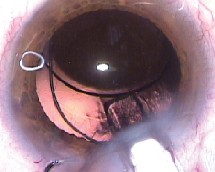 Bausch & Lomb's SofPort Advanced Optics (AO) aberration-free aspheric intraocular lens is a three-piece silicone lens with a 360-degree square edge, and PMMA haptics. The anterior and posterior surfaces are aspheric.
Bausch & Lomb's SofPort Advanced Optics (AO) aberration-free aspheric intraocular lens is a three-piece silicone lens with a 360-degree square edge, and PMMA haptics. The anterior and posterior surfaces are aspheric.
